Deep Neural Network (DNN) for Efficient User Clustering and Power Allocation in Downlink Non-Orthogonal Multiple Access (NOMA) 5G Networks
Abstract
:1. Introduction
1.1. Prior Works
1.2. Motivations and Contributions
- A new NOMA-based DNN architecture is developed and the DNN model is adapted to various NOMA environments with asymmetrical channel fading to carry out UC operation. A novel algorithm for the DNN-UC scheme is developed for the BS to optimally cluster the users before transmitting the superposed signals to different clusters.
- The proposed DNN-UC model is comprehensively trained using a back-propagation learning algorithm with datasets containing cluster formation in a large variety of NOMA scenarios. Then, the trained model is validated by examining the mean squared error (MSE) in the testing phase.
- An efficient power allocation scheme is derived based on the ultimate coalition formation to further enhance the throughput attainment subject to the SIC constraints.
- Optimization of the hyper-parameters during the learning process of the DNN model is performed extensively to minimize the MSE and maximize the sum throughput to achieve a symmetrical balance between the MSE and throughput. The impact of different activation functions on the performance of the DNN-UC is also analyzed.
- The performance of the DNN-UC scheme in terms of throughput maximization is investigated for different NOMA environments to demonstrate the capability of the proposed scheme of adapting to various scenarios.
1.3. Organization of the Paper
2. System Model and Problem Formulation
2.1. Channel and System Models for 5G NOMA-Based Networks
2.2. User Clustering Problem Formulation
3. Proposed DNN Based UC in NOMA
3.1. Description of UC Dataset
3.2. Working Principle of DNN Based UC
3.3. Power Allocation for Predicted UC
4. Simulation Results and Analysis
4.1. Simulation Settings
4.2. Simulation Results and Discussions
5. Conclusions
Author Contributions
Funding
Institutional Review Board Statement
Informed Consent Statement
Conflicts of Interest
References
- Saito, Y.; Benjebbour, A.; Kishiyama, Y.; Nakamura, T. System-level performance evaluation of downlink non-orthogonal multiple access (NOMA). In Proceedings of the PIMRC IEEE International Symposium on Personal, Indoor, and Mobile Radio Communications, London, UK, 8–11 September 2013; pp. 611–615. [Google Scholar]
- Dai, L.; Wang, B.; Yuan, Y.; Han, S.; Chih-Lin, I.; Wang, Z. Non-orthogonal multiple access for 5G: Solutions, challenges, opportunities, and future research trends. IEEE Commun. Mag. 2015, 53, 74–81. [Google Scholar] [CrossRef]
- Ding, Z.; Lei, X.; Karagiannidis, G.K.; Schober, R.; Yuan, J.; Bhargava, V.K. A survey on non-orthogonal multiple access for 5G networks: Research challenges and future trends. IEEE J. Sel. Areas Commun. 2017, 35, 2181–2195. [Google Scholar] [CrossRef] [Green Version]
- Huang, H.; Xiong, J.; Yang, J.; Gui, G.; Sari, H. Rate region analysis in a full-duplex-aided cooperative non orthogonal multiple-access system. IEEE Access 2015, 5, 17869–17880. [Google Scholar] [CrossRef]
- Chen, Y.; Wang, L.; Ai, Y.; Jiao, B.; Hanzo, L. Performance analysis of NOMA-SM in vehicle-to-vehicle massive MIMO channels. IEEE J. Sel. Areas Commun. 2017, 35, 2653–2666. [Google Scholar] [CrossRef]
- Wei, Z.; Ng, D.W.K.; Yuan, J.; Wang, H.M. Optimal resource allocation for power-efficient MC-NOMA with imperfect channel state information. IEEE Trans. Commun. 2017, 65, 3944–3961. [Google Scholar] [CrossRef] [Green Version]
- Ding, Z.; Yang, Z.; Fan, P.; Poor, H.V. On the performance of non-orthogonal multiple access in 5G systems with randomly deployed users. IEEE Signal Process. Lett. 2014, 21, 1501–1505. [Google Scholar] [CrossRef] [Green Version]
- Yang, L.; Chen, J.; Ni, Q.; Shi, J.; Xue, X. NOMA-enabled cooperative unicast–multicast: Design and outage analysis. IEEE Trans. Wirel. Commun. 2017, 16, 7870–7889. [Google Scholar] [CrossRef]
- Oviedo, J.A.; Sadjadpour, H.R. A fair power allocation approach to NOMA in multiuser SISO systems. IEEE Trans. Veh. Technol. 2017, 66, 7974–7985. [Google Scholar] [CrossRef] [Green Version]
- Yue, X.; Liu, Y.; Kang, S.; Nallanathan, A.; Ding, Z. Outage performance of full/half-duplex user relaying in NOMA systems. In Proceedings of the IEEE International Conference on Communications, Paris, France, 21–25 May 2017; pp. 1–6. [Google Scholar]
- Ding, Z.; Fan, P.; Poor, H.V. Impact of user pairing on 5G nonorthogonal multiple-access downlink transmissions. IEEE Trans. Veh. Technol. 2015, 65, 6010–6023. [Google Scholar] [CrossRef]
- Ding, Z.; Peng, M.; Poor, H.V. Cooperative non-orthogonal multiple access in 5G systems. IEEE Commun. Lett. 2015, 19, 1462–1465. [Google Scholar] [CrossRef] [Green Version]
- Ma, Y.; Gao, H.; Lv, T.; Lu, Y. Novel user clustering schemes for downlink NOMA system. In Proceedings of the IEEE Military Communications Conference, Baltimore, MD, USA, 23–25 October 2017; pp. 191–196. [Google Scholar]
- Ali, M.S.; Tabassum, H.; Hossain, E. Dynamic user clustering and power allocation for uplink and downlink non-orthogonal multiple access (NOMA) systems. IEEE Access 2016, 4, 6325–6343. [Google Scholar] [CrossRef]
- Kumaresan, S.P.; Tan, C.K.; Lee, C.K.; Ng, Y.H. Adaptive user clustering for downlink non orthogonal multiple access based 5G systems using Brute-force search. Trans. Emerg. Telecommun. Technol. 2020, 31, 4098. [Google Scholar]
- Kumaresan, S.P.; Tan, C.K.; Lee, C.K.; Ng, Y.H. Low-complexity particle swarm optimization based adaptive user clustering for downlink non-orthogonal multiple access deployed for 5G systems. World Rev. Sci. Technol. Sustain. Dev. 2020, 1, 1. [Google Scholar]
- Kumaresan, S.P.; Tan, C.K.; Ng, Y.H. Efficient User Clustering Using a Low-Complexity Artificial Neural Network (ANN) for 5G NOMA Systems. IEEE Access 2020, 8, 179307–179316. [Google Scholar] [CrossRef]
- Hinton, G.E.; Osindero, S.; Teh, Y.W. A fast learning algorithm for deep belief nets. Neural Comput. 2006, 18, 1527–1554. [Google Scholar] [CrossRef]
- Ye, H.; Li, G.Y.; Juang, B.H. Power of deep learning for channel estimation and signal detection in OFDM systems. IEEE Wirel. Commun. Lett. 2017, 7, 114–117. [Google Scholar] [CrossRef]
- Fadlullah, Z.M.; Tang, F.; Mao, B.; Kato, N.; Akashi, O.; Inoue, T.; Mizutani, K. State-of-the-art deep learning: Evolving machine intelligence toward tomorrow’s intelligent network traffic control systems. IEEE Commun. Surv. Tutor. 2017, 19, 2432–2455. [Google Scholar] [CrossRef]
- Tang, F.; Mao, B.; Fadlullah, Z.M.; Kato, N.; Akashi, O.; Inoue, T.; Mizutani, K. On removing routing protocol from future wireless networks: A real-time deep learning approach for intelligent traffic control. IEEE Wirel. Commun. 2017, 25, 154–160. [Google Scholar] [CrossRef]
- Kato, N.; Fadlullah, Z.M.; Mao, B.; Tang, F.; Akashi, O.; Inoue, T.; Mizutani, K. The deep learning vision for heterogeneous network traffic control: Proposal, challenges, and future perspective. IEEE Wirel. Commun. 2016, 24, 146–153. [Google Scholar] [CrossRef]
- Mao, B.; Fadlullah, Z.M.; Tang, F.; Kato, N.; Akashi, O.; Inoue, T.; Mizutani, K. Routing or computing? The paradigm shift towards intelligent computer network packet transmission based on deep learning. IEEE Trans. Comput. 2017, 66, 1946–1960. [Google Scholar] [CrossRef]
- Gui, G.; Huang, H.; Song, Y.; Sari, H. Deep learning for an effective non orthogonal multiple access scheme. IEEE Trans.Veh. Technol. 2018, 67, 8440–8450. [Google Scholar] [CrossRef]
- Lin, C.; Chang, Q.; Xianxu, L. A Deep Learning Approach for MIMO-NOMA Downlink Signal Detection. Sensors 2019, 19, 2526. [Google Scholar] [CrossRef] [Green Version]
- Luo, J.; Tang, J.; So, D.K.; Chen, G.; Cumanan, K.; Chambers, J.A. A deep learning-based approach to power minimization in multi-carrier NOMA with SWIPT. IEEE Access 2019, 7, 17450–17460. [Google Scholar] [CrossRef]
- Saetan, W.; Thipchaksurat, S. Application of deep learning to energy-efficient power allocation scheme for 5G SC-NOMA system with imperfect SIC. In Proceedings of the IEEE International Conference on Electrical Engineering/Electronics, Computer, Telecommunications and Information Technology, Pattaya, Thailand, 10–13 July 2019; pp. 661–664. [Google Scholar]
- Sim, I.; Sun, Y.G.; Lee, D.; Kim, S.H.; Lee, J.; Kim, J.H.; Kim, J.Y. Deep Learning Based Successive Interference Cancellation Scheme in Nonorthogonal Multiple Access Downlink Network. Energies 2020, 13, 6237. [Google Scholar] [CrossRef]
- Pan, J.; Ye, N.; Wang, A.; Li, X. A Deep Learning-Aided Detection Method for FTN-Based NOMA. Wirel. Commun. Mob. Comput. 2020, 2020, 5684851. [Google Scholar] [CrossRef] [Green Version]
- Yang, N.; Zhang, H.; Long, K.; Hsieh, H.Y.; Liu, J. Deep neural network for resource management in NOMA networks. IEEE Trans. Veh. Technol. 2020, 69, 876–886. [Google Scholar] [CrossRef]
- Maas, A.L.; Hannun, A.Y.; Ng, A.Y. Rectifier nonlinearities improve neural network acoustic models. In Proceedings of the ICML Workshop on Deep Learning for Audio, Speech, and Language Processing (WDLASL), Atlanta, GA, USA, 16 June 2013; pp. 1–6. [Google Scholar]
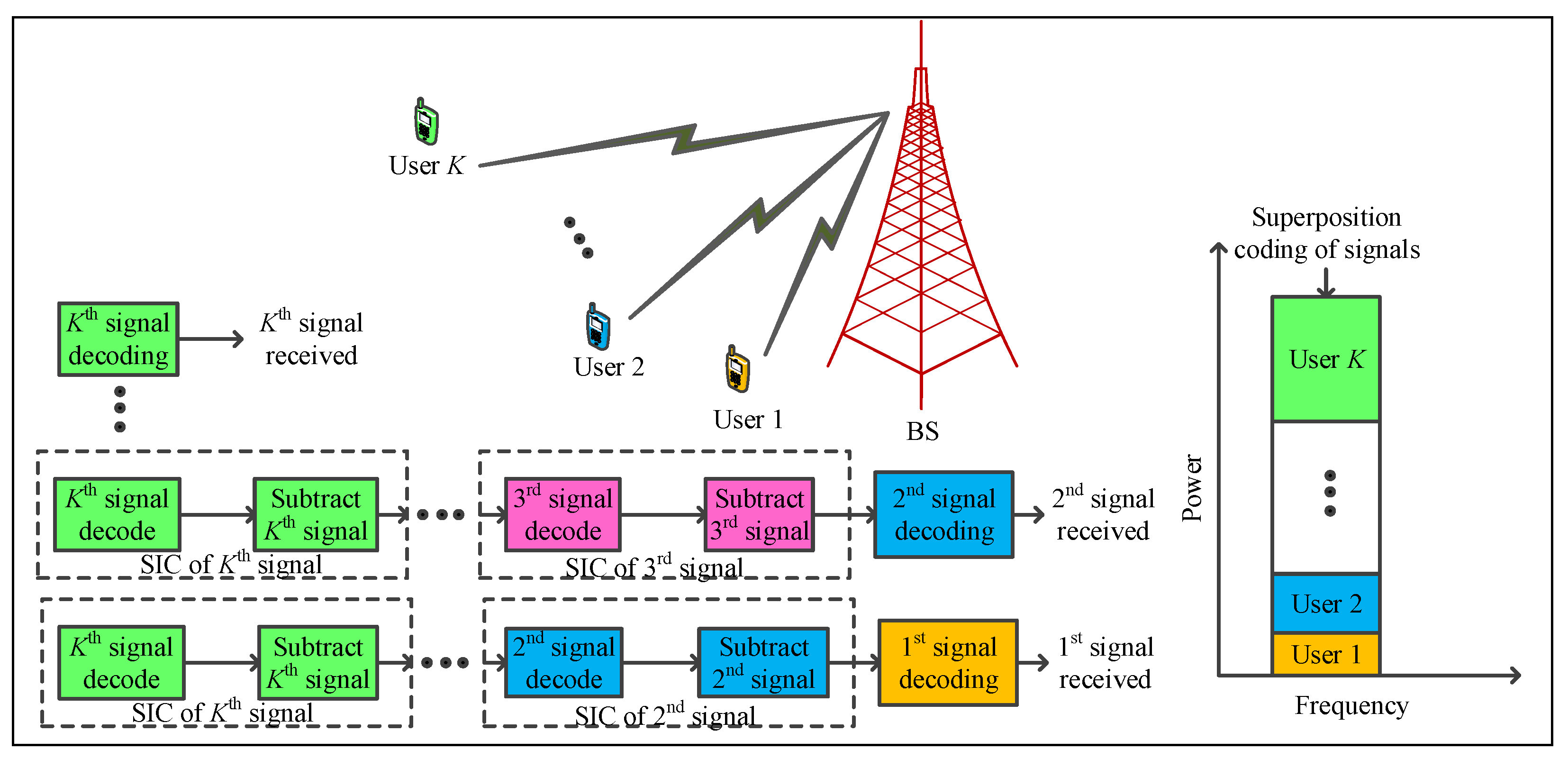

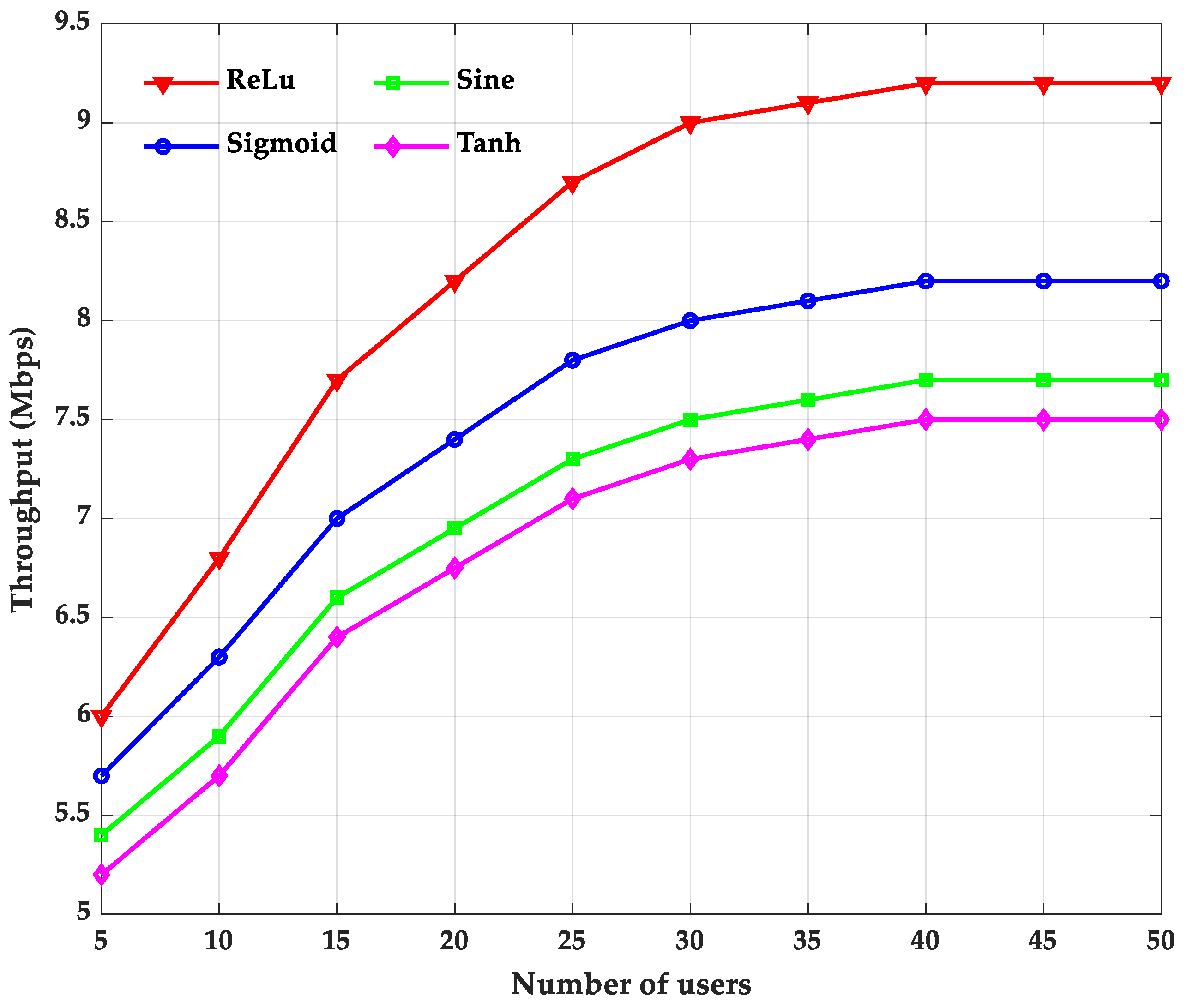
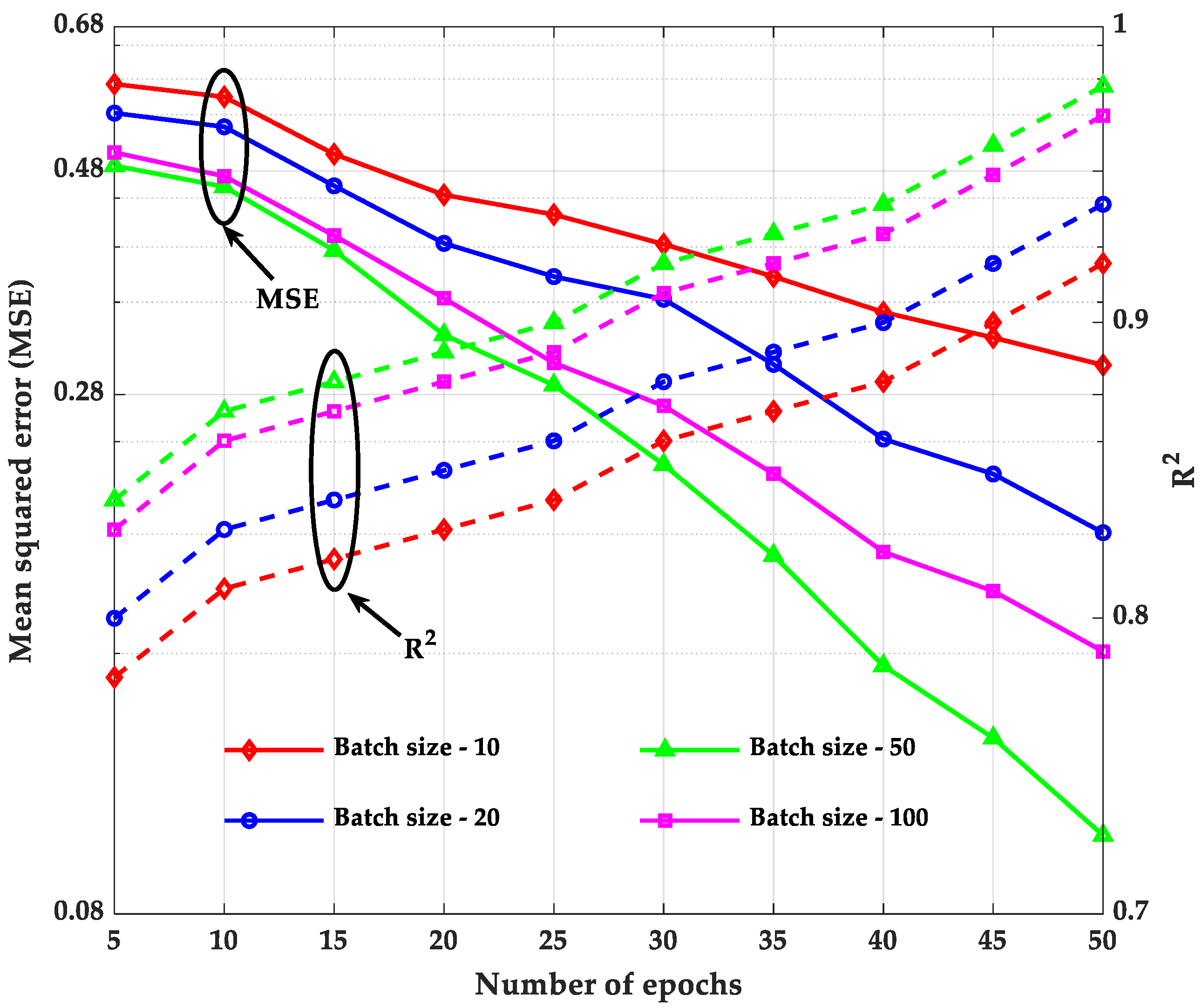



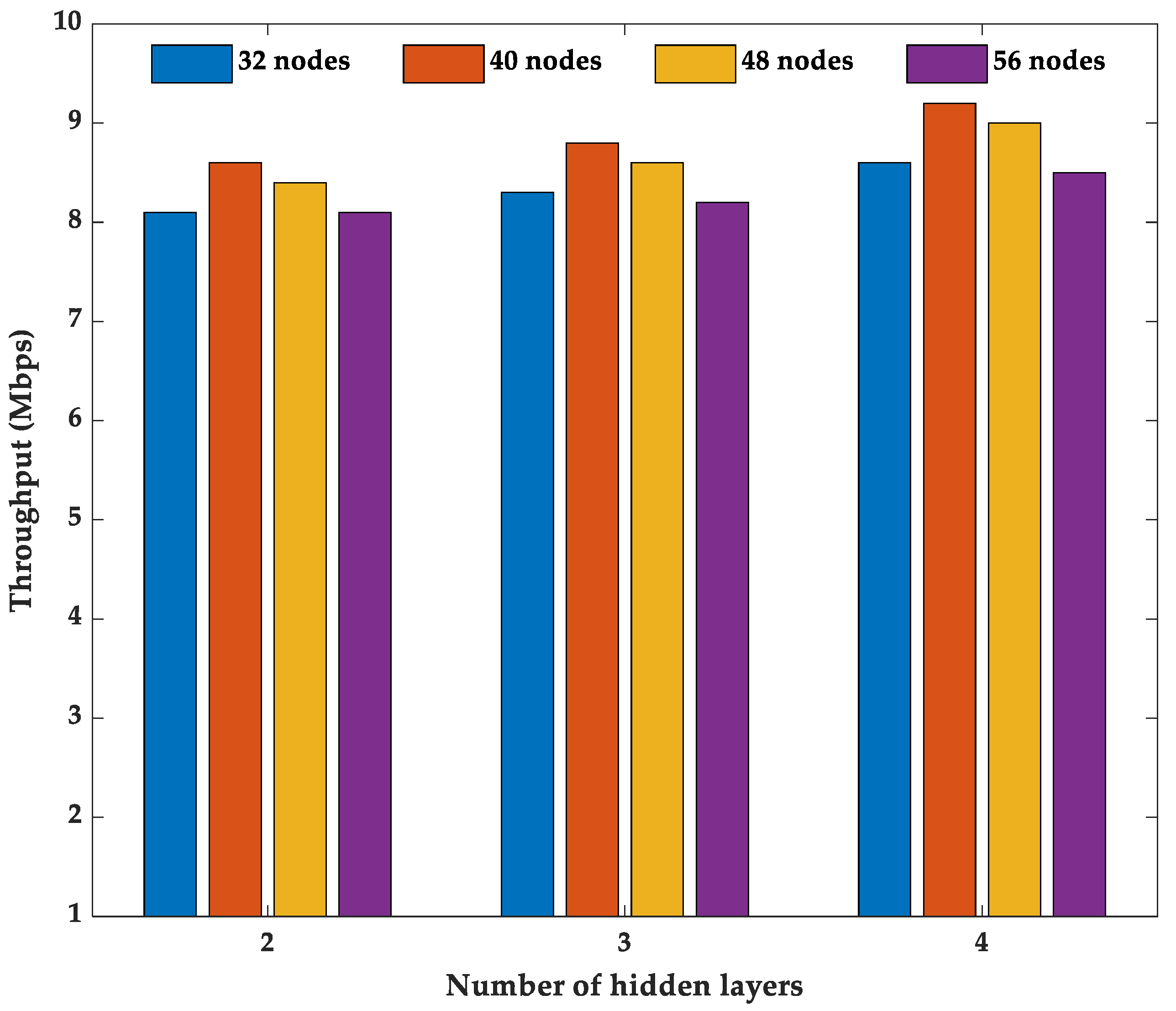
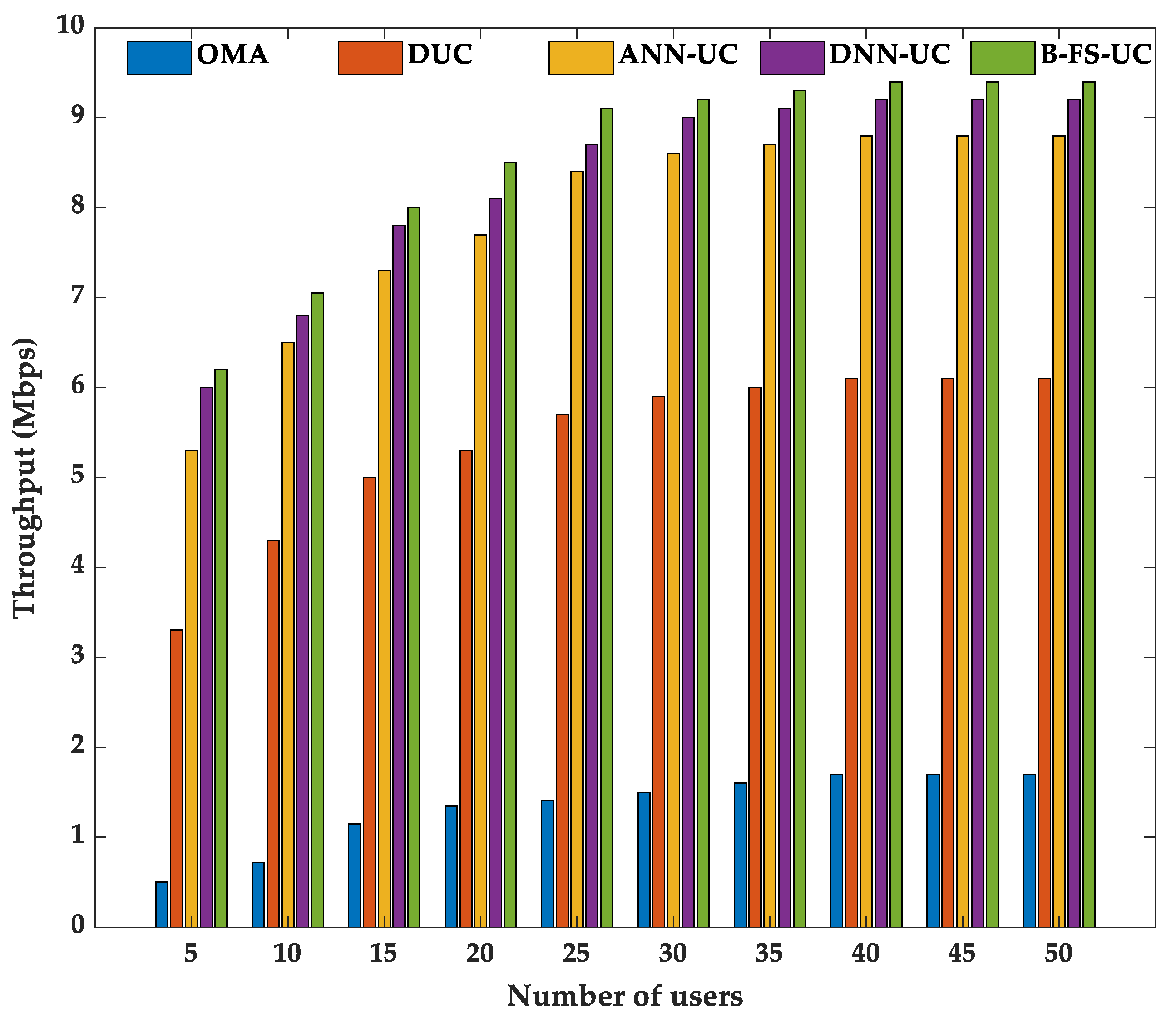
| Notations | Description |
|---|---|
| Number of users | |
| Number of subcarriers | |
| Bandwidth | |
| User index | |
| Subcarrier index | |
| Transmit power of user on subcarrier | |
| Channel gain of user on subcarrier | |
| Bell number to partition number of users | |
| Cluster size | |
| User set | |
| Cluster index | |
| Total of cluster number formed | |
| Minimum power difference | |
| Maximum downlink transmission power for a cluster | |
| Minimum power variance required to perform SIC | |
| Received signal at | |
| Transmitted signal from the BS to | |
| Signal-to-interference-plus-noise ratio (SINR) for | |
| Achievable throughput for | |
| Achievable throughput for cluster | |
| Total system throughput | |
| Number of input layer nodes | |
| Number of hidden layers | |
| Number of output layer nodes | |
| Input vector of DNN-UC | |
| Output vector of DNN-UC | |
| Hidden layer index | |
| Number of hidden layer nodes | |
| Weight matrix that links (q-1) th layer to the q-th layer | |
| Activation function for the th layer | |
| Bias vector for the th layer | |
| Output vector of hidden layer | |
| Predicted UC at the output of DNN-UC | |
| Cost function | |
| Step size | |
| Total number of samples |
| Parameter | Value |
|---|---|
| Number of hidden layers | 4 |
| Number of data samples | 110,000 |
| Length of training data | 50,000, 60,000, 70,000, 80,000 |
| Length of validation data | 15,000 |
| Length of testing data | 15,000 |
| Learning rate | 0.1, 0.02, 0.01, 0.002, 0.001 |
| Number of input layer nodes | 48 |
| Number of hidden layer nodes | 40 |
| Number of output layer nodes | 24 |
| Batch sizes | 10, 20, 50, 100 |
| Activation functions | ReLu, Sigmoid, Sine, Tanh |
| Parameter | Value |
|---|---|
| Cell radius | 100 m |
| Bandwidth of the resource, | 180 kHz |
| Downlink transmission power for cluster, | 46 dBm |
| Detection threshold at SIC receiver, | 10 dBm |
| Noise power | −118 dBm |
| Number of NOMA users | 2–24 |
| Number of subcarriers | 256 |
| Path loss | |
| Shadowing effect | , , . |
Publisher’s Note: MDPI stays neutral with regard to jurisdictional claims in published maps and institutional affiliations. |
© 2021 by the authors. Licensee MDPI, Basel, Switzerland. This article is an open access article distributed under the terms and conditions of the Creative Commons Attribution (CC BY) license (https://creativecommons.org/licenses/by/4.0/).
Share and Cite
Kumaresan, S.P.; Tan, C.K.; Ng, Y.H. Deep Neural Network (DNN) for Efficient User Clustering and Power Allocation in Downlink Non-Orthogonal Multiple Access (NOMA) 5G Networks. Symmetry 2021, 13, 1507. https://doi.org/10.3390/sym13081507
Kumaresan SP, Tan CK, Ng YH. Deep Neural Network (DNN) for Efficient User Clustering and Power Allocation in Downlink Non-Orthogonal Multiple Access (NOMA) 5G Networks. Symmetry. 2021; 13(8):1507. https://doi.org/10.3390/sym13081507
Chicago/Turabian StyleKumaresan, S. Prabha, Chee Keong Tan, and Yin Hoe Ng. 2021. "Deep Neural Network (DNN) for Efficient User Clustering and Power Allocation in Downlink Non-Orthogonal Multiple Access (NOMA) 5G Networks" Symmetry 13, no. 8: 1507. https://doi.org/10.3390/sym13081507
APA StyleKumaresan, S. P., Tan, C. K., & Ng, Y. H. (2021). Deep Neural Network (DNN) for Efficient User Clustering and Power Allocation in Downlink Non-Orthogonal Multiple Access (NOMA) 5G Networks. Symmetry, 13(8), 1507. https://doi.org/10.3390/sym13081507






